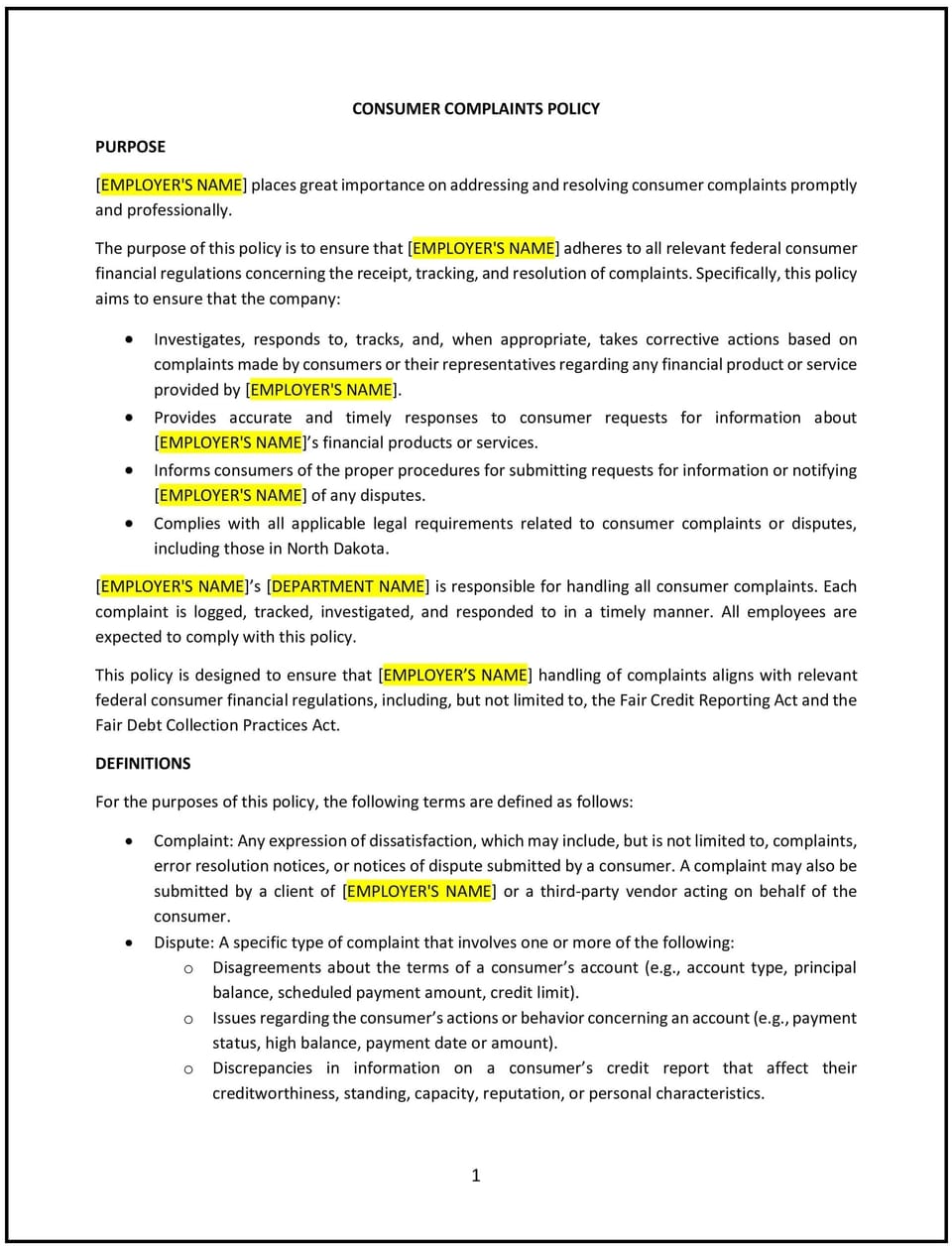Consumer complaints policy (North Dakota): Free template

Consumer complaints policy (North Dakota)
This consumer complaints policy is designed to help North Dakota businesses establish procedures for receiving, investigating, and resolving customer complaints. The policy outlines response timelines, resolution procedures, and record-keeping requirements to maintain high service standards.
By implementing this policy, businesses can improve customer satisfaction, manage disputes effectively, and enhance their reputation.
How to use this consumer complaints policy (North Dakota)
- Define complaint channels: Specify how customers can submit complaints (e.g., phone, email, website).
- Establish response timelines: Set expectations for acknowledging and resolving complaints.
- Outline investigation procedures: Require businesses to review complaints, gather relevant information, and determine appropriate resolutions.
- Provide resolution options: Offer refunds, service corrections, or other remedies based on the nature of the complaint.
- Maintain records: Document complaints, resolutions, and trends to improve service quality.
- Address escalation procedures: Define steps for unresolved complaints, including appeals or third-party mediation.
- Review regularly: Update the policy based on consumer feedback and business needs.
Benefits of using this consumer complaints policy (North Dakota)
Implementing this policy provides several advantages for North Dakota businesses:
- Improves customer satisfaction: Ensures complaints are addressed in a timely and fair manner.
- Reduces legal risks: Helps businesses resolve disputes before they escalate into legal issues.
- Enhances brand reputation: Demonstrates a commitment to customer service excellence.
- Supports operational improvements: Identifies recurring issues and areas for service enhancements.
- Reflects North Dakota-specific considerations: Aligns with local consumer protection laws and industry standards.
Tips for using this consumer complaints policy (North Dakota)
- Provide multiple reporting options: Allow customers to submit complaints through various channels.
- Train customer service teams: Ensure employees handle complaints professionally and efficiently.
- Track and analyze complaint trends: Use data to identify recurring issues and improve service delivery.
- Implement follow-up procedures: Ensure customers are informed of resolutions and next steps.
- Adjust as needed: Update policies based on customer feedback and evolving business practices.
Q: How should businesses handle customer complaints?
A: Businesses should acknowledge complaints promptly, investigate issues thoroughly, and offer fair resolutions.
Q: What are acceptable resolution options for complaints?
A: Businesses should determine solutions such as refunds, replacements, service corrections, or goodwill gestures.
Q: Should businesses document customer complaints?
A: Yes, businesses should maintain records of complaints and resolutions for quality improvement and compliance.
Q: Can customers escalate complaints if unsatisfied?
A: Businesses should define escalation procedures, including manager reviews or third-party mediation options.
Q: How often should this policy be reviewed?
A: The policy should be reviewed annually or as needed to reflect changes in customer service practices.
This article contains general legal information and does not contain legal advice. Cobrief is not a law firm or a substitute for an attorney or law firm. The law is complex and changes often. For legal advice, please ask a lawyer.


